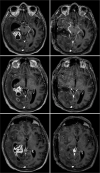Brain cryptococcoma mimicking a glioblastoma in an immunocompetent patient: A rare case report and comprehensive review
- PMID: 35509529
- PMCID: PMC9062938
- DOI: 10.25259/SNI_1243_2021
Brain cryptococcoma mimicking a glioblastoma in an immunocompetent patient: A rare case report and comprehensive review
Abstract
Background: Cryptococcosis is an invasive fungal infection primarily affecting lungs and potentially spreading to the central nervous. This fungal infection might be misdiagnosed as other infection diseases, such as tuberculosis; granulomatous diseases, like sarcoidosis; and even neoplastic diseases. Some previous reports described cases of cryptococcomas resembling brain tumors. In this paper, we present a very rare presentation of brain cryptococcoma mimicking a malignant glioma. To the best of our knowledge, this is the third case description in the literature.
Case description: A 64-year-old male patient presented at the hospital with a history of progressive frontal headache for 1 month, becoming moderate to severe, associated with visual changes, without nausea or vomiting. No fever was reported. He was a heavy smoker and denied other relevant previous medical data. Neuroimage disclosed a right temporal expansive lesion initially considered a malignant glioma. The patient underwent a right temporal craniotomy and biopsy revealed a cryptococcoma.
Conclusion: Cryptococcomas characteristics in magnetic resonance are quite nonspecific. They should always be included in differential diagnosis of expansive brain lesions, both malignant and benign. Therefore, once cryptococcomas may resemble like other intracranial expansive lesions, biopsy should always be carried out to clarify diagnosis and avoid inadequate treatment and definition of prognosis only based on radiological patterns.
Keywords: Brain neoplasm; Differential diagnosis; Neurocryptococcosis; Surgery.
Copyright: © 2022 Surgical Neurology International.
Conflict of interest statement
There are no conflicts of interest.
Figures





Similar articles
-
Cryptococcoma mimicking a brain tumor in an immunocompetent patient: case report of an extremely rare presentation.Sao Paulo Med J. 2018 Sep-Oct;136(5):492-496. doi: 10.1590/1516-3180.2017.0046210417. Epub 2017 Nov 6. Sao Paulo Med J. 2018. PMID: 29116307 Free PMC article.
-
Middle cerebral artery infarction, A rare complication of intracranial cryptococcoma in an immunocompetent patient: A case report and literature review.Front Surg. 2023 Feb 15;10:1083833. doi: 10.3389/fsurg.2023.1083833. eCollection 2023. Front Surg. 2023. PMID: 36874457 Free PMC article.
-
Cerebral cryptococcoma mimicking glioblastoma.BMJ Case Rep. 2017 Feb 10;2017:bcr2016218824. doi: 10.1136/bcr-2016-218824. BMJ Case Rep. 2017. PMID: 28188169 Free PMC article.
-
Cerebral Cryptococcomas: A Systematic Scoping Review of Available Evidence to Facilitate Diagnosis and Treatment.Pathogens. 2022 Feb 3;11(2):205. doi: 10.3390/pathogens11020205. Pathogens. 2022. PMID: 35215148 Free PMC article.
-
Multiple cerebral gliomas mimicking central nervous system inflammatory demyelinating diseases: A rare case with review of literature.Medicine (Baltimore). 2017 Dec;96(52):e9456. doi: 10.1097/MD.0000000000009456. Medicine (Baltimore). 2017. PMID: 29384930 Free PMC article. Review.
Cited by
-
Multiple Central Nervous System Cryptococcomas Masquerading as Lymphoma.Neurohospitalist. 2024 Dec 9:19418744241307413. doi: 10.1177/19418744241307413. Online ahead of print. Neurohospitalist. 2024. PMID: 39664490 Free PMC article.
-
Advances of MR imaging in glioma: what the neurosurgeon needs to know.Acta Neurochir (Wien). 2025 Jun 21;167(1):174. doi: 10.1007/s00701-025-06593-6. Acta Neurochir (Wien). 2025. PMID: 40542873 Free PMC article. Review.
-
A case of immunocompetent intracranial cryptococcoma in which intraoperative rapid pathological diagnosis and polymerase chain reaction led to early treatment: What to know to avoid misdiagnosis as brain tumor.Surg Neurol Int. 2024 Sep 13;15:330. doi: 10.25259/SNI_614_2024. eCollection 2024. Surg Neurol Int. 2024. PMID: 39372983 Free PMC article.
-
Cerebral cryptococcoma successfully treated by isavuconazole in an immunocompetent patient: A case report.Radiol Case Rep. 2022 Dec 20;18(3):824-829. doi: 10.1016/j.radcr.2022.11.011. eCollection 2023 Mar. Radiol Case Rep. 2022. PMID: 36582749 Free PMC article.
-
Pituitary cryptococcoma in an immunocompetent patient with panhypopituitarism: illustrative case.J Neurosurg Case Lessons. 2023 May 8;5(19):CASE2372. doi: 10.3171/CASE2372. Print 2023 May 8. J Neurosurg Case Lessons. 2023. PMID: 37158394 Free PMC article.
References
-
- Ang SY, Ng VW, Kumar SD, Low SY. Cryptococcosis mimicking lung carcinoma with brain metastases in an immunocompetent patient. J Clin Neurosci. 2017;35:73–5. - PubMed
-
- Chen S, Chen X, Zhang Z, Quan L, Kuang S, Luo X. MRI findings of cerebral cryptococcosis in immunocompetent patients. J Med Imaging Radiat Oncol. 2011;55:52–7. - PubMed
-
- Goldman DL, Khine H, Abadi J, Lindenberg DJ, La P, Niang R, et al. Serologic evidence for Cryptococcus neoformans infection in early childhood. Pediatrics. 2001;107:e66. - PubMed
-
- Khandelwal N, Gupta V, Singh P. Central nervous system fungal infections in tropics. Neuroimaging Clin N Am. 2011;21:859–66. - PubMed
Publication types
LinkOut - more resources
Full Text Sources
